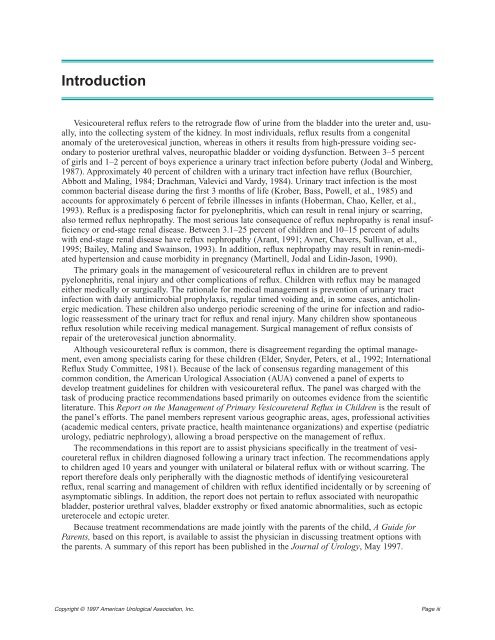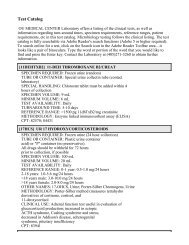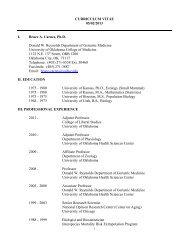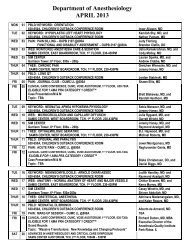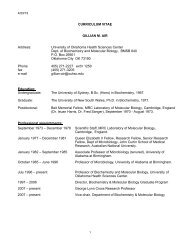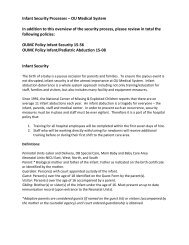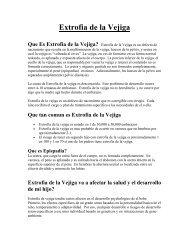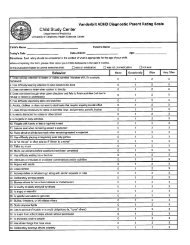The American Urlogical Association - OU Medicine
The American Urlogical Association - OU Medicine
The American Urlogical Association - OU Medicine
You also want an ePaper? Increase the reach of your titles
YUMPU automatically turns print PDFs into web optimized ePapers that Google loves.
Introduction<br />
Vesicoureteral reflux refers to the retrograde flow of urine from the bladder into the ureter and, usually,<br />
into the collecting system of the kidney. In most individuals, reflux results from a congenital<br />
anomaly of the ureterovesical junction, whereas in others it results from high-pressure voiding secondary<br />
to posterior urethral valves, neuropathic bladder or voiding dysfunction. Between 3–5 percent<br />
of girls and 1–2 percent of boys experience a urinary tract infection before puberty (Jodal and Winberg,<br />
1987). Approximately 40 percent of children with a urinary tract infection have reflux (Bourchier,<br />
Abbott and Maling, 1984; Drachman, Valevici and Vardy, 1984). Urinary tract infection is the most<br />
common bacterial disease during the first 3 months of life (Krober, Bass, Powell, et al., 1985) and<br />
accounts for approximately 6 percent of febrile illnesses in infants (Hoberman, Chao, Keller, et al.,<br />
1993). Reflux is a predisposing factor for pyelonephritis, which can result in renal injury or scarring,<br />
also termed reflux nephropathy. <strong>The</strong> most serious late consequence of reflux nephropathy is renal insufficiency<br />
or end-stage renal disease. Between 3.1–25 percent of children and 10–15 percent of adults<br />
with end-stage renal disease have reflux nephropathy (Arant, 1991; Avner, Chavers, Sullivan, et al.,<br />
1995; Bailey, Maling and Swainson, 1993). In addition, reflux nephropathy may result in renin-mediated<br />
hypertension and cause morbidity in pregnancy (Martinell, Jodal and Lidin-Jason, 1990).<br />
<strong>The</strong> primary goals in the management of vesicoureteral reflux in children are to prevent<br />
pyelonephritis, renal injury and other complications of reflux. Children with reflux may be managed<br />
either medically or surgically. <strong>The</strong> rationale for medical management is prevention of urinary tract<br />
infection with daily antimicrobial prophylaxis, regular timed voiding and, in some cases, anticholinergic<br />
medication. <strong>The</strong>se children also undergo periodic screening of the urine for infection and radiologic<br />
reassessment of the urinary tract for reflux and renal injury. Many children show spontaneous<br />
reflux resolution while receiving medical management. Surgical management of reflux consists of<br />
repair of the ureterovesical junction abnormality.<br />
Although vesicoureteral reflux is common, there is disagreement regarding the optimal management,<br />
even among specialists caring for these children (Elder, Snyder, Peters, et al., 1992; International<br />
Reflux Study Committee, 1981). Because of the lack of consensus regarding management of this<br />
common condition, the <strong>American</strong> Urological <strong>Association</strong> (AUA) convened a panel of experts to<br />
develop treatment guidelines for children with vesicoureteral reflux. <strong>The</strong> panel was charged with the<br />
task of producing practice recommendations based primarily on outcomes evidence from the scientific<br />
literature. This Report on the Management of Primary Vesicoureteral Reflux in Children is the result of<br />
the panel’s efforts. <strong>The</strong> panel members represent various geographic areas, ages, professional activities<br />
(academic medical centers, private practice, health maintenance organizations) and expertise (pediatric<br />
urology, pediatric nephrology), allowing a broad perspective on the management of reflux.<br />
<strong>The</strong> recommendations in this report are to assist physicians specifically in the treatment of vesicoureteral<br />
reflux in children diagnosed following a urinary tract infection. <strong>The</strong> recommendations apply<br />
to children aged 10 years and younger with unilateral or bilateral reflux with or without scarring. <strong>The</strong><br />
report therefore deals only peripherally with the diagnostic methods of identifying vesicoureteral<br />
reflux, renal scarring and management of children with reflux identified incidentally or by screening of<br />
asymptomatic siblings. In addition, the report does not pertain to reflux associated with neuropathic<br />
bladder, posterior urethral valves, bladder exstrophy or fixed anatomic abnormalities, such as ectopic<br />
ureterocele and ectopic ureter.<br />
Because treatment recommendations are made jointly with the parents of the child, A Guide for<br />
Parents, based on this report, is available to assist the physician in discussing treatment options with<br />
the parents. A summary of this report has been published in the Journal of Urology, May 1997.<br />
Copyright © 1997 <strong>American</strong> Urological <strong>Association</strong>, Inc.<br />
Page iii


